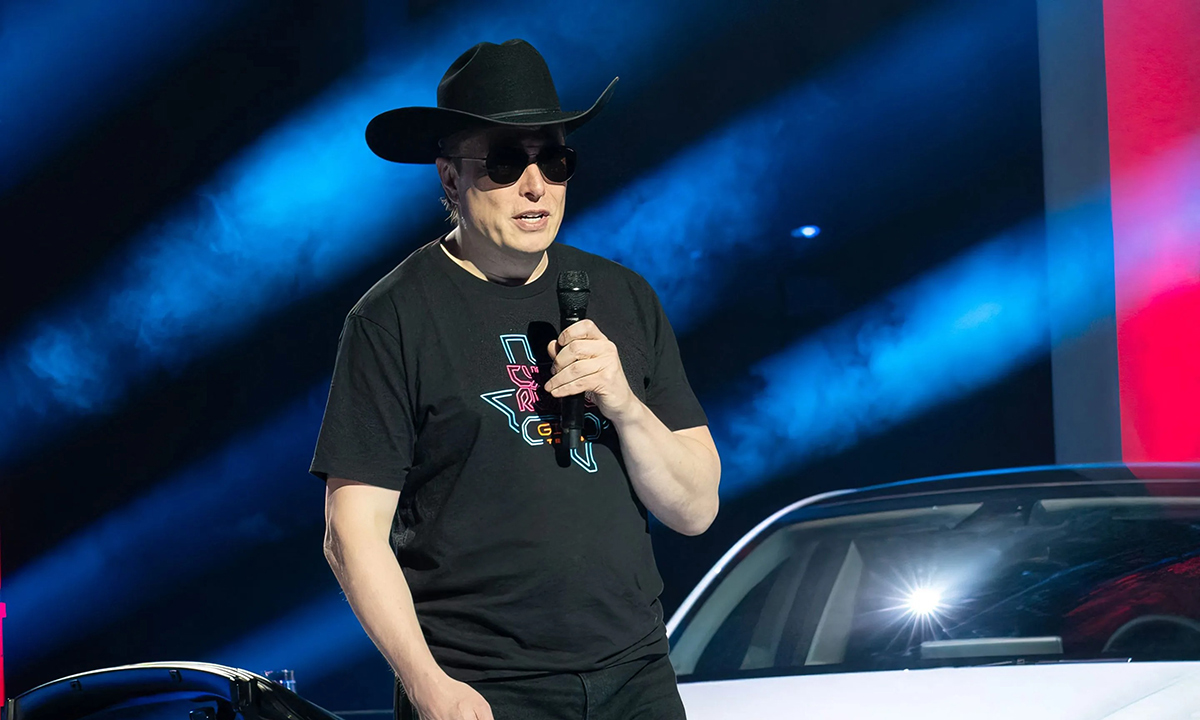
“特斯拉公司(Tesla)不會(huì)在任何不允許我們銷售和維護(hù)汽車的地方建廠,?!卑B ゑR斯克最近在推特上回應(yīng)關(guān)于其印度計(jì)劃的問題時(shí)表示。就像馬斯克最近說的其他一些事情一樣,,這并沒有反映現(xiàn)實(shí),。
印度中央政府和許多邦一直在不遺余力地設(shè)法讓特斯拉公司在印度建制造工廠,從而利用該國巨大的市場(chǎng)潛力,。馬斯克想要的是一份進(jìn)口中國制造的汽車而無需繳納任何關(guān)稅的許可證,,這可以讓馬斯克在與其他汽車制造商的競(jìng)爭中擁有優(yōu)勢(shì),而印度卻沒有準(zhǔn)備好提供這份許可證,。
另外,,印度正在開發(fā)新一代面向大眾的電動(dòng)汽車,有望主導(dǎo)全球市場(chǎng),。這些電動(dòng)汽車融合了最新的技術(shù)突破——不像特斯拉汽車,,特斯拉汽車的基礎(chǔ)技術(shù)已經(jīng)有十多年的歷史了,除了一些軟件升級(jí)和危險(xiǎn)的自動(dòng)駕駛技術(shù)之外,,什么都沒有,。
對(duì)印度來說,在這個(gè)技術(shù)飛速發(fā)展的時(shí)代,,特斯拉汽車就像20世紀(jì)50年代印度大使牌(Hindustan Ambassador)老式汽車一樣過時(shí),后者在80年代中期之前一直在印度占據(jù)主導(dǎo)地位,。塔塔汽車公司(Tata Motors)開發(fā)的概念車Avinya是特斯拉公司在6年前就應(yīng)該開發(fā)的車型,。馬欣德拉公司(Mahindra)將于今年7月推出的“Born Again”電動(dòng)汽車可能與特斯拉車型一樣功能強(qiáng)大,但價(jià)格不到特斯拉的一半,。鑒于這些公司已經(jīng)擁有全球影響力——塔塔汽車公司擁有捷豹汽車(Jaguar),,馬欣德拉公司是最大的拖拉機(jī)和皮卡供應(yīng)商之一——本人迫切地期望這些產(chǎn)品在美國上市。
在你把我當(dāng)成另一個(gè)做空特斯拉的人或別有用心的人之前,,讓我先說明一下我和馬斯克的私人交情和特斯拉汽車的使用體驗(yàn),。
在2012年馬斯克讓我排在候補(bǔ)名單的前列之后,我成了Model S的首批購買者之一,。在洛杉磯??怂闺娪爸破荆‵ox Studios)舉辦的一場(chǎng)討論會(huì)中,馬斯克為我的第一本書《移民外流》(Immigrant Exodus)背書,并可能第一次透露了他想在火星退休的計(jì)劃,。那時(shí)候,,特斯拉公司瀕臨破產(chǎn),馬斯克不斷受到持懷疑態(tài)度的記者的抨擊,,尤其是《紐約時(shí)報(bào)》的記者,。在《華盛頓郵報(bào)》的一篇文章中,我自稱是“特斯拉粉絲”,,對(duì)Model S贊不絕口,,稱其為“輪子上的宇宙飛船”。隨后,,我寫了很多文章稱贊馬斯克,,并為他辯護(hù)。
我還在2016年賣掉了我的舊特斯拉,,買了一輛新的,,以便為馬斯克所說的將在兩年內(nèi)增加自動(dòng)駕駛功能的軟件升級(jí)做好準(zhǔn)備。他的銷售主管發(fā)來的電子郵件證實(shí),,我購買的汽車配備了特斯拉所謂的全自動(dòng)駕駛功能 (FSD) 所需的所有硬件,。
軟件升級(jí)一直沒有到來。特斯拉的技術(shù)與六年前基本相同?,F(xiàn)在我被告知,,如果我想要實(shí)現(xiàn)全自動(dòng)駕駛功能,我需要再買一輛新車,。更糟糕的是,,特斯拉公司要求消費(fèi)者在虛高的汽車價(jià)格基礎(chǔ)上再支付1.2萬美元,才能實(shí)現(xiàn)全自動(dòng)駕駛功能,。坦率地說,,鑒于許多關(guān)于特斯拉撞車事件的報(bào)道和我所經(jīng)歷的負(fù)面經(jīng)歷,我不再相信該公司所說的任何事情,。特斯拉汽車的自動(dòng)駕駛系統(tǒng)曾把我的車撞到車庫門上,,我在路上遇到過很多次僥幸脫險(xiǎn)的經(jīng)歷,包括在美國公共電視網(wǎng)新聞時(shí)間(PBS NewsHour)的保羅·索曼(Paul Solman)拍攝的一個(gè)片段中,,我對(duì)著特斯拉汽車大發(fā)雷霆,。
我認(rèn)為特斯拉的技術(shù)永遠(yuǎn)不會(huì)實(shí)現(xiàn)安全自動(dòng)駕駛,因?yàn)樗狈线m的傳感器,,而主要依賴?yán)弦淮臄z像頭,。但像Waymo公司和Cruise公司這樣使用更先進(jìn)的激光雷達(dá)傳感器、行事更謹(jǐn)慎的公司可能會(huì)實(shí)現(xiàn)安全自動(dòng)駕駛,。我甚至買了一輛Model X,,因?yàn)槲蚁胍F(xiàn)代的外觀和感覺——但我退了它,,因?yàn)樗膬?nèi)飾似乎是由廉價(jià)塑料制成的,而且這輛車有設(shè)計(jì)缺陷,。
因此,,在愛上特斯拉汽車十年之后,我準(zhǔn)備放棄了,。
印度沒有特斯拉公司在美國和中國建造的超級(jí)工廠,,因此,在電池生產(chǎn)方面可能會(huì)落后,。但在這方面,,時(shí)間和技術(shù)也可能站在印度這一邊。這場(chǎng)競(jìng)賽的黑馬是信實(shí)集團(tuán)(Reliance)的穆克什·安巴尼(Mukesh Ambani),,他最近以1億英鎊的價(jià)格收購了一家英國公司Faradion公司,。在電子郵件交流中,我推測(cè)他有在全球推廣鈉離子電池的野心,。
Faradion公司的鈉離子電池有著與特斯拉汽車使用的鋰電池幾乎相同的能量密度和功率——但生產(chǎn)成本極低,,而且不會(huì)對(duì)環(huán)境造成破壞,這是因?yàn)殁c資源豐富且易于獲取,。對(duì)于電動(dòng)汽車制造商來說,,付出增加電池質(zhì)量的微小代價(jià)可能是值得的,因?yàn)槭澜缟洗蠖鄶?shù)人并不需要300英里的續(xù)航里程,,而這似乎是美國消費(fèi)者想要的,。鈉離子電池在寒冷環(huán)境下的性能也更好,并且不受導(dǎo)致鋰離子電池起火的熱失控的影響,。
馬斯克堅(jiān)持印度政府無法接受的條件,,這可能是給印度的一份大禮:這將為印度汽車行業(yè)提供必要的發(fā)展空間,從而制造出將席卷全球汽車行業(yè)的汽車,,而這些汽車會(huì)奪取特斯拉公司的市場(chǎng)份額,。(財(cái)富中文網(wǎng))
維維克·瓦德瓦是一位學(xué)者、企業(yè)家和作家,。他的最新著作《從增量到指數(shù)》(From Incremental to Exponential)解釋了大公司如何看待未來并重新思考創(chuàng)新,。
譯者:中慧言-王芳
“特斯拉公司(Tesla)不會(huì)在任何不允許我們銷售和維護(hù)汽車的地方建廠?!卑B ゑR斯克最近在推特上回應(yīng)關(guān)于其印度計(jì)劃的問題時(shí)表示。就像馬斯克最近說的其他一些事情一樣,,這并沒有反映現(xiàn)實(shí),。
印度中央政府和許多邦一直在不遺余力地設(shè)法讓特斯拉公司在印度建制造工廠,從而利用該國巨大的市場(chǎng)潛力,。馬斯克想要的是一份進(jìn)口中國制造的汽車而無需繳納任何關(guān)稅的許可證,,這可以讓馬斯克在與其他汽車制造商的競(jìng)爭中擁有優(yōu)勢(shì),,而印度卻沒有準(zhǔn)備好提供這份許可證。
另外,,印度正在開發(fā)新一代面向大眾的電動(dòng)汽車,,有望主導(dǎo)全球市場(chǎng)。這些電動(dòng)汽車融合了最新的技術(shù)突破——不像特斯拉汽車,,特斯拉汽車的基礎(chǔ)技術(shù)已經(jīng)有十多年的歷史了,,除了一些軟件升級(jí)和危險(xiǎn)的自動(dòng)駕駛技術(shù)之外,什么都沒有,。
對(duì)印度來說,,在這個(gè)技術(shù)飛速發(fā)展的時(shí)代,特斯拉汽車就像20世紀(jì)50年代印度大使牌(Hindustan Ambassador)老式汽車一樣過時(shí),,后者在80年代中期之前一直在印度占據(jù)主導(dǎo)地位,。塔塔汽車公司(Tata Motors)開發(fā)的概念車Avinya是特斯拉公司在6年前就應(yīng)該開發(fā)的車型。馬欣德拉公司(Mahindra)將于今年7月推出的“Born Again”電動(dòng)汽車可能與特斯拉車型一樣功能強(qiáng)大,,但價(jià)格不到特斯拉的一半,。鑒于這些公司已經(jīng)擁有全球影響力——塔塔汽車公司擁有捷豹汽車(Jaguar),馬欣德拉公司是最大的拖拉機(jī)和皮卡供應(yīng)商之一——本人迫切地期望這些產(chǎn)品在美國上市,。
在你把我當(dāng)成另一個(gè)做空特斯拉的人或別有用心的人之前,,讓我先說明一下我和馬斯克的私人交情和特斯拉汽車的使用體驗(yàn)。
在2012年馬斯克讓我排在候補(bǔ)名單的前列之后,,我成了Model S的首批購買者之一,。在洛杉磯福克斯電影制片公司(Fox Studios)舉辦的一場(chǎng)討論會(huì)中,,馬斯克為我的第一本書《移民外流》(Immigrant Exodus)背書,,并可能第一次透露了他想在火星退休的計(jì)劃。那時(shí)候,,特斯拉公司瀕臨破產(chǎn),,馬斯克不斷受到持懷疑態(tài)度的記者的抨擊,尤其是《紐約時(shí)報(bào)》的記者,。在《華盛頓郵報(bào)》的一篇文章中,,我自稱是“特斯拉粉絲”,對(duì)Model S贊不絕口,,稱其為“輪子上的宇宙飛船”,。隨后,我寫了很多文章稱贊馬斯克,,并為他辯護(hù),。
我還在2016年賣掉了我的舊特斯拉,買了一輛新的,,以便為馬斯克所說的將在兩年內(nèi)增加自動(dòng)駕駛功能的軟件升級(jí)做好準(zhǔn)備,。他的銷售主管發(fā)來的電子郵件證實(shí),,我購買的汽車配備了特斯拉所謂的全自動(dòng)駕駛功能 (FSD) 所需的所有硬件。
軟件升級(jí)一直沒有到來,。特斯拉的技術(shù)與六年前基本相同?,F(xiàn)在我被告知,如果我想要實(shí)現(xiàn)全自動(dòng)駕駛功能,,我需要再買一輛新車,。更糟糕的是,特斯拉公司要求消費(fèi)者在虛高的汽車價(jià)格基礎(chǔ)上再支付1.2萬美元,,才能實(shí)現(xiàn)全自動(dòng)駕駛功能,。坦率地說,鑒于許多關(guān)于特斯拉撞車事件的報(bào)道和我所經(jīng)歷的負(fù)面經(jīng)歷,,我不再相信該公司所說的任何事情,。特斯拉汽車的自動(dòng)駕駛系統(tǒng)曾把我的車撞到車庫門上,我在路上遇到過很多次僥幸脫險(xiǎn)的經(jīng)歷,,包括在美國公共電視網(wǎng)新聞時(shí)間(PBS NewsHour)的保羅·索曼(Paul Solman)拍攝的一個(gè)片段中,,我對(duì)著特斯拉汽車大發(fā)雷霆。
我認(rèn)為特斯拉的技術(shù)永遠(yuǎn)不會(huì)實(shí)現(xiàn)安全自動(dòng)駕駛,,因?yàn)樗狈线m的傳感器,,而主要依賴?yán)弦淮臄z像頭。但像Waymo公司和Cruise公司這樣使用更先進(jìn)的激光雷達(dá)傳感器,、行事更謹(jǐn)慎的公司可能會(huì)實(shí)現(xiàn)安全自動(dòng)駕駛,。我甚至買了一輛Model X,因?yàn)槲蚁胍F(xiàn)代的外觀和感覺——但我退了它,,因?yàn)樗膬?nèi)飾似乎是由廉價(jià)塑料制成的,,而且這輛車有設(shè)計(jì)缺陷。
因此,,在愛上特斯拉汽車十年之后,,我準(zhǔn)備放棄了。
印度沒有特斯拉公司在美國和中國建造的超級(jí)工廠,,因此,,在電池生產(chǎn)方面可能會(huì)落后。但在這方面,,時(shí)間和技術(shù)也可能站在印度這一邊,。這場(chǎng)競(jìng)賽的黑馬是信實(shí)集團(tuán)(Reliance)的穆克什·安巴尼(Mukesh Ambani),他最近以1億英鎊的價(jià)格收購了一家英國公司Faradion公司,。在電子郵件交流中,,我推測(cè)他有在全球推廣鈉離子電池的野心。
Faradion公司的鈉離子電池有著與特斯拉汽車使用的鋰電池幾乎相同的能量密度和功率——但生產(chǎn)成本極低,而且不會(huì)對(duì)環(huán)境造成破壞,,這是因?yàn)殁c資源豐富且易于獲取。對(duì)于電動(dòng)汽車制造商來說,,付出增加電池質(zhì)量的微小代價(jià)可能是值得的,,因?yàn)槭澜缟洗蠖鄶?shù)人并不需要300英里的續(xù)航里程,而這似乎是美國消費(fèi)者想要的,。鈉離子電池在寒冷環(huán)境下的性能也更好,,并且不受導(dǎo)致鋰離子電池起火的熱失控的影響。
馬斯克堅(jiān)持印度政府無法接受的條件,,這可能是給印度的一份大禮:這將為印度汽車行業(yè)提供必要的發(fā)展空間,,從而制造出將席卷全球汽車行業(yè)的汽車,而這些汽車會(huì)奪取特斯拉公司的市場(chǎng)份額,。(財(cái)富中文網(wǎng))
維維克·瓦德瓦是一位學(xué)者,、企業(yè)家和作家。他的最新著作《從增量到指數(shù)》(From Incremental to Exponential)解釋了大公司如何看待未來并重新思考創(chuàng)新,。
譯者:中慧言-王芳
"Tesla will not put a manufacturing plant in any location where we are not allowed first to sell & service cars,” Elon Musk recently tweeted, in response to a question about its plans for India. Like some other things Musk has been saying of late, this did not reflect reality.
Many Indian states, and the central government, have been bending over backward to get Tesla to establish a manufacturing plant in India and take advantage of the country’s massive market. What Musk wanted, and India was not prepared to offer, was a license to import its Chinese-made vehicles without any duties, providing it with an advantage over every other automaker.
India’s government made absolutely the right decision in locking out the Chinese-made Teslas, because India is developing a new generation of electric vehicles, built for the masses, which could dominate global markets. These incorporate the latest technology breakthroughs—unlike the Teslas, whose underlying tech is now more than a decade old, with nothing more than some software upgrades and a dangerous autonomous-driving technology.
For India, in this age of exponentially advancing technologies, the Teslas are as out of date as were the 1950s vintage Hindustan Ambassador cars that dominated its roads until the mid-‘80s. The concept car that Tata Motors has developed, the Avinya, is what Tesla should have evolved into six years ago. The “Born Again” electric cars that Mahindra is unveiling this July are likely to be as functional as Tesla’s models, while costing less than half as much. Given the global reach these companies already have—Tata owns Jaguar, and Mahindra is among the largest supplier of tractors and pickup trucks—I’ll eagerly wait for these to be available in the U.S.
Before you write me off as another Tesla short-seller or someone with an axe to grind, let me tell you about my background with Musk and Tesla.
I became one of the first purchasers of the Model S after Musk had me bumped to the front of the waiting list in 2012. Musk had endorsed my first book, Immigrant Exodus, and disclosed for perhaps the first time his plans to retire on Mars, at a discussion we held at an event at Fox Studios in Los Angeles. In those days, Tesla was on the verge of bankruptcy, and Musk was taking incessant fire from skeptical journalists, particularly one from The New York Times. In an article in The Washington Post, I proclaimed myself a “Tesla fanboy” and raved about the Model S, calling it a “spaceship on wheels.” Subsequently, I wrote many articles defending and praising Musk.
I also sold my original Tesla and bought a new one in 2016, to be ready for the software upgrades that Musk said would add autonomous-driving capabilities within two years. E-mails from his sales executives confirmed that the car I was purchasing had all the hardware necessary for what Tesla calls Full Self-Driving (FSD).
The upgrades never arrived. Tesla’s technology is essentially the same as it was six years ago. Now I am told that if I want FSD, I will need to buy another new car. And to add insult to injury, Tesla wants $12,000 on top of an inflated car price for this feature. Frankly, given the many reports about Tesla collisions and the negative experiences I have had, I no longer trust anything that the company says. The car’s autopilot once drove the car into my garage door, and I’ve had many close calls on the road, including while being filmed by PBS NewsHour’s Paul Solman for a segment in which I was raving about my Tesla.
I don’t believe that Tesla’s technology will ever drive itself safely because it lacks the proper sensors, relying mainly on older-generation cameras. But companies such as Waymo and Cruise, which are using more advanced lidar sensors and treading more carefully, likely will. I had even purchased a Model X because I wanted a more modern look and feel – but I returned it because the interior seemed to be constructed of cheap plastic and the car had design defects.
Therefore, a decade after falling in love with Tesla, I am ready to break up.
India, which lacks the gigafactories that Tesla has built in the U.S. and China, could be left behind in battery production. But, here too, time and technology may be on India’s side. The dark horse in this race is Reliance’s Mukesh Ambani, who recently purchased a British company, Faradion, for 100 million pounds. In e-mail exchanges, I surmised that he had global ambition concerning sodium-ion batteries.
Faradion’s sodium-ion batteries have almost the same energy density and power as the lithium cells that Tesla uses—but can be produced for a fraction of the price, without the environmental destruction, because sodium is abundant and easy to capture. The slight tradeoff in extra mass may be worth it to EV manufacturers, because most people around the world don’t need the 300-mile range that consumers in the U.S. seem to desire. The sodium-ion batteries also perform better in the cold and aren't subject to the thermal runaway that has led lithium-ion batteries to burst into flames.
Musk’s insistence upon conditions unacceptable to the Indian government may be a major gift to India: It will provide the Indian automotive industry the space necessary to build vehicles that will take the global automotive industry by storm. And they will eat Elon’s lunch.
Vivek Wadhwa is an academic, entrepreneur, and author. His latest book, From Incremental to Exponential, explains how large companies can see the future and rethink innovation.






